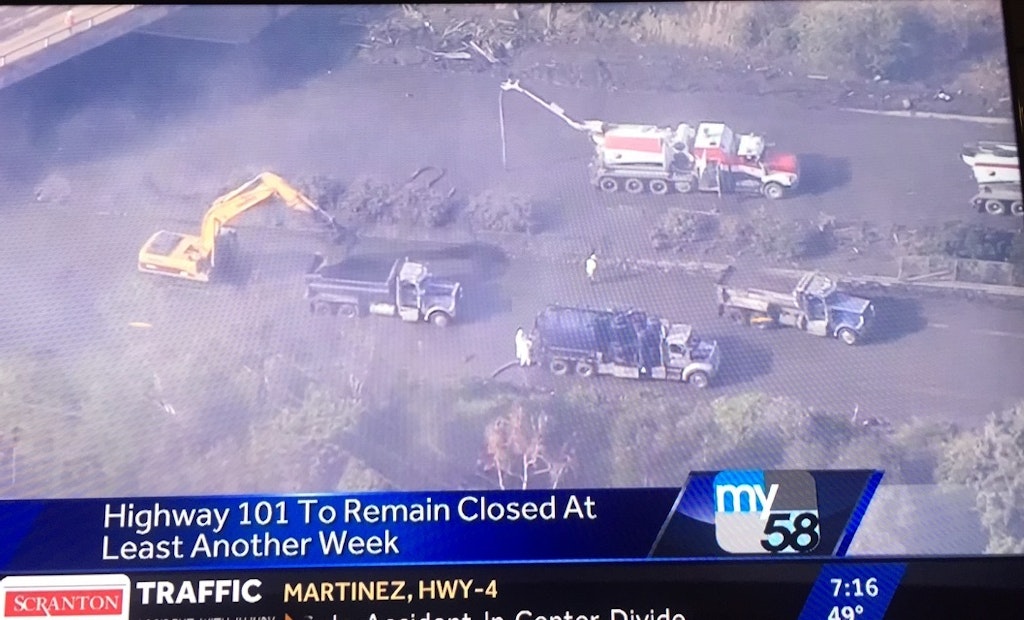
In this screenshot from a TV news report about the mudslide cleanup, a Discovery Hydrovac truck being operated by Barry Kiser can be seen in the upper portion of the screen.
Barry Kiser pulled up in his company’s hydroexcavator about 6 a.m. last Saturday on a stretch of U.S. Highway 101 near Montecito, California. It was a scene like nothing he had ever witnessed.
The road was completely covered by mud and debris following flooding and mudslides days earlier. Kiser, a senior operator at California-based Discovery Hydrovac, was the first person from the company on site to help with cleanup efforts.
“Organized chaos,” Kiser says. “There were so many people there. We were all trying to get one job done, but there were so many different factors in getting that job done.”
Kiser made the six-hour-plus drive south from Modesto after Discovery Hydrovac area supervisor Brent Lowe received a call late Friday night to see if the company had any trucks available to send. Lowe was told that the mud and debris was about 4 to 5 feet deep — depending on the area — for a half-mile.
“The area we were working in, they called it a recovery area because they said they were still missing people,” says Lowe, who coordinated the company’s trucks on the scene. “When the guys were down there they said they had guys watching all the vacuum trucks, including ours, to see if they saw bodies or anything like that. That was a little stressful for the guys. We never saw anything, thank God.”
Long Days Ahead
The debris on the highway was varied — everything from lifeguard buoys to garbage cans to tree limbs.
Kiser worked a 12-hour shift the first day before a co-worker subbed in to split shifts. On Sunday, Kiser worked 7 a.m. to 7 p.m. before being relieved. Discovery Hydrovac sent two additional trucks on Sunday and two more arrived on Monday. The crews were told on Tuesday about noon that they could head home.
“What we were doing was two of those trucks were running 24 hours a day basically,” Lowe says. “Then the other trucks were working 14 hours a day.”
In all, Discovery Hydrovac had five trucks and six operators work the cleanup effort.
“This is a normal job for us to have this many trucks and operators on,” Lowe says. “The scope of the work is obviously different in that we’re not digging in the ground, we’re just sucking mud up off the ground. That’s the only thing that really changed for us.”
When the hydrovac trucks were in use on the highway, they were in a line formation, spaced out about a vehicle distance between each one. There were a number of other hydrovac companies working the massive cleanup effort, as well.
“You would load, go dump and come back and wait in a line, ready to back in and then the next person goes,” Kiser says. “It was just a conveyor belt.”
Kiser says on each daily shift he personally collected four or five loads. The trucks can handle around 38,000 pounds per load. That amounted to Kiser sucking up roughly 76 to 95 tons of mud and debris daily. During his three and half days working, Kiser carried away around 300 to 350 total tons.
Eye-Opening Experience
In Kiser’s four and a half years as an operator with the company, he’s never experienced anything close to the mudslide cleanup.
“I’ve been called out on pipeline explosions and ruptures and I’d have to be first on the scene,” Kiser says. “You can see (the mudslide cleanup) on the news, but nothing compares to seeing it in person.”
Working an emergency scenario was an eye-opening experience for Discovery Hydrovac’s operators. It was also a circumstance in which Discovery Hydrovac’s employees had to work alongside companies that are direct competitors. However, for those few days working on Highway 101, all the workers were teammates.
“It was learning to work with other companies and not view them as competitors or that they’re taking money away from us,” Lowe says. “Rather it’s, hey, people have lost homes, lost cars and have trauma they’re going through. It was about putting our differences aside and working together and trying to help clean this up and remedy the situation.”
Kiser was proud of the work his crews and other statewide crews did to help in the disaster relief.
“We were all working for a common goal, a common cause and we were there to get people back to normalcy, because it was devastating,” Kiser says. “You think the fires (in Santa Rosa) were devastating — and, gosh, they were, I’m not downplaying the fires — but this and the cleanup and how long it’s going to take. It’s sad because I know I can go to my home and they can’t. It was a very heartfelt assignment we went on. Everybody stepped up and did their job and was focused. Nobody was standing around doing nothing. It was just constant, and it was so amazing to see.”





